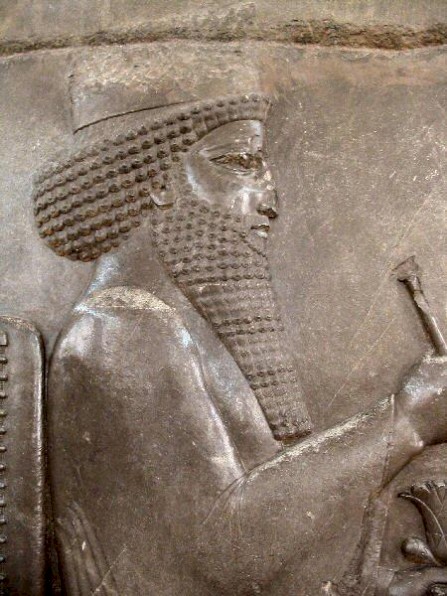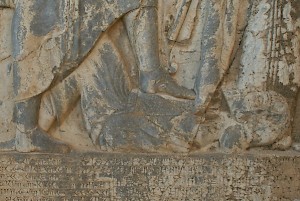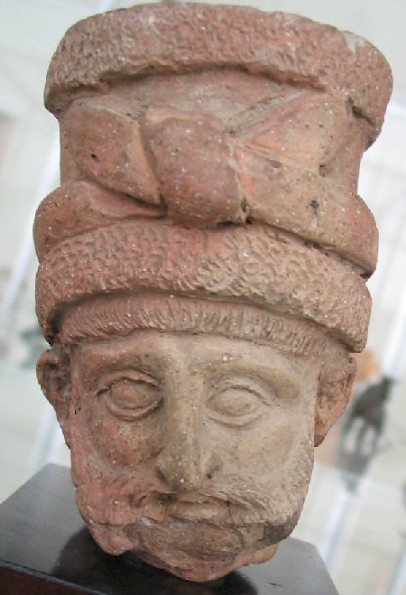Darius the Great: Coup d'etat
Q44387Darius I (Old Persian Dârayavauš): king of ancient Persia, whose reign lasted from 522 to 486. He seized power after killing king Gaumâta, fought a civil war (described in the Behistun inscription), and was finally able to refound the Achaemenid empire, which had been very loosely organized until then. Darius fought several foreign wars, which brought him to India and Thrace. When he died, the Persian empire had reached its largest extent. He was succeeded by his son Xerxes.

When Darius became king in 522 BCE, the Persian empire was in great turmoil. It had been founded less than thirty years before by Cyrus the Great, who had defeated his Median overlord Astyages in 550 and had taken over his empire.
Three years later, Cyrus had conquered Lydia in western Turkey, where the proverbially rich king Croesus had been his victim. In 539, it was the Babylonian king Nabonidus' turn to lose an empire. The Persian armies had also conquered large parts of Central Asia, but when Cyrus had ventured too much to the north, he had been defeated and killed by tribesmen (530). He was buried at Pasargadae, the town he had once built on the site of his first victory.
His son Cambyses had succeeded him. He had continued his father's policy of adding new countries to the empire, and conquered Egypt in 525. According to Greek sources like the Histories of Herodotus of Halicarnassus, this king had lost his mind when he heard that his brother Smerdis, whom he believed to be dead, had revolted in 522. Cambyses wanted to rush back to Persia, but when he jumped into the saddle of his horse, the cap fell off the sheath of his sword, exposing the blade, which pierced his thigh. Cambyses died in Syria, without children, leaving the army without commander and the empire to Smerdis - or someone who resembled him.
Herodotus' story is more or less identical to the official Persian propaganda. In the Behistun inscription (which will be discussed below), we read a more or less identical story, although it uses the real name of Smerdis, Bardiya.
Cambyses slew Bardiya. When Cambyses slew him, it was not known unto the people that Bardiya was slain. Thereupon Cambyses went to Egypt. When Cambyses had departed into Egypt, the people became hostile, and the lie multiplied in the land, even in Persia and Media, and in the other provinces.
Afterwards, there was a certain man, a Magian, Gaumâta by name, who raised a rebellion [...]. On the fourteenth day of the month Viyaxana [11 March 522] did he rebel. He lied to the people, saying: 'I am Smerdis, the son of Cyrus, the brother of Cambyses.' Then were all the people in revolt, and from Cambyses they went over unto him, both Persia and Media, and the other provinces. He seized the kingdom [...]. Afterwards, Cambyses died of natural causes.note

According to Herodotus, courtiers of Smerdis/Bardiya/Gaumâta discovered the truth and started to conspire against the new king. The Greek researcher mentions six noblemen: Otanes, Gobryas, Intaphrenes, Hydarnes, Megabyzus, and Aspathines. They are undecided about the course they have to follow, until Darius arrives in Susa, one of the capitals of the Persian empire. The newcomer, who is a distant relative of Cambyses (his father Hystaspes and Cyrus had the same great-grandfather), joins the six. No guard dares to interfere when the six noblemen visit the royal palace, and in the end, Darius kills the false king. After some debate, everyone accepts Darius as king.
In the Behistun inscription, Darius tells essentially the same story, although he implies that he himself was the leader of the conspiracy:
There was none who dared to act against Gaumâta, the Magian, until I came. Then I prayed to Ahuramazda; Ahuramazda brought me help. On the tenth day of the month Bâgayâdiš [29 September 522] I, with a few men, slew that Gaumâta, the Magian, and the chief men who were his followers. At the stronghold called Sikayauvatiš, in the district called Nisaia in Media, I slew him; I dispossessed him of the kingdom. By the grace of Ahuramazda I became king; Ahuramazda granted me the kingdom.note
Although there are differences (was the usurper killed in Susa or Sikayauvatiš?), the outline of the story is the same. Without a battle but during a fight in a palace, Darius personally kills the usurper. It is also interesting to note that the names of the conspirators are almost identical to those mentioned by Herodotus: the only difference is that Darius mentions Ardumaniš instead of Aspathines.

Of course there remain several puzzles. In the first place, we have to accept that for months, Gaumâta was not recognized as the fraud he was. To us, this is hard to believe, but in fact, this was not impossible. The ancients had no photos and it was difficult to identify a person with absolute security. We know about several imposters who were able to trick entire provinces (in the first century CE, there were at least three false Neros in the eastern half of the Roman empire). In the second place: is it not likely that Bardiya/Smerdis was really Bardiya/Smerdis, and not the Magian Gaumâta? The possibility can certainly not be excluded that Darius did not kill an usurper, but a man who had a far better claim to the throne.
Darius was now king, but his kingdom was falling in pieces, and civil war broke out. Before we discuss the first regnal year, we must discuss how Darius was able to create unity among the Persians; and before we can do that, we must take a better look at the sources we have already used: the Behistun inscription and Herodotus' Histories.